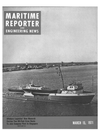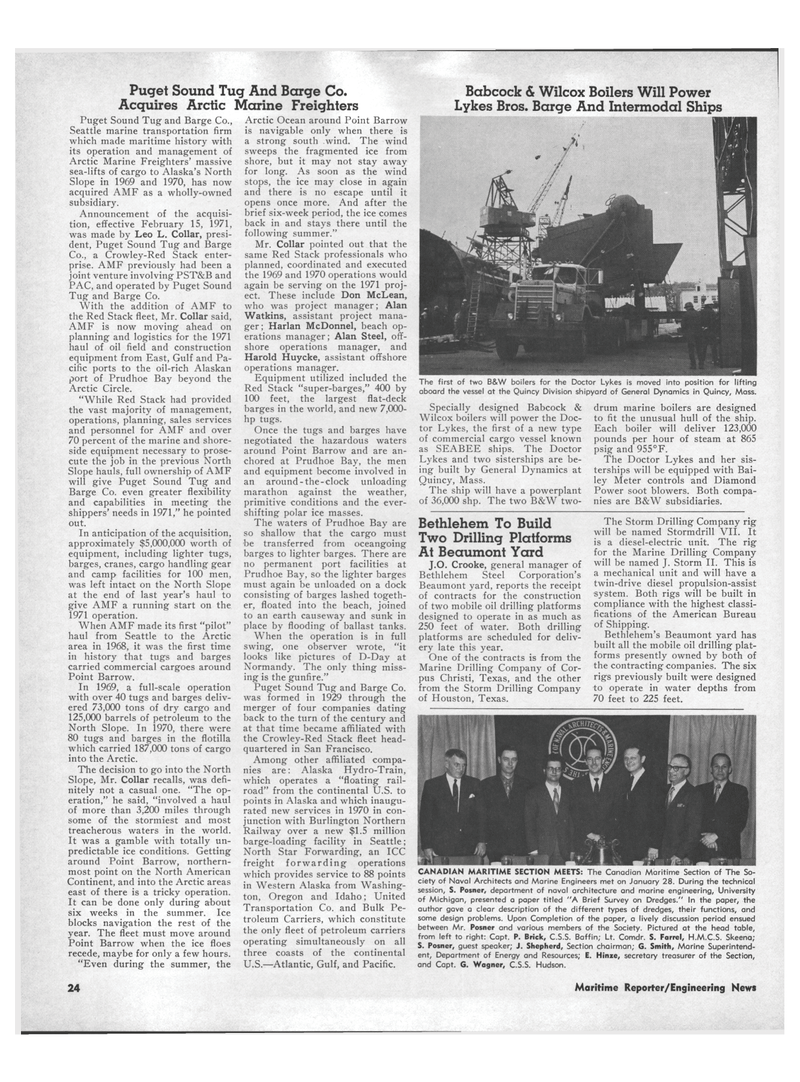
Page 22: of Maritime Reporter Magazine (March 15, 1971)
Read this page in Pdf, Flash or Html5 edition of March 15, 1971 Maritime Reporter Magazine
Puget Sound Tug And Barge Co.
Acquires Arctic Marine Freighters
Puget Sound Tug and Barge Co.,
Seattle marine transportation firm which made maritime history with its operation and management of
Arctic Marine Freighters' massive sea-lifts of cargo to Alaska's North
Slope in 1969 and 1970, has now acquired AMF as a wholly-owned subsidiary.
Announcement of the acquisi- tion, effective February 15, 1971, was made by Leo L. Collar, presi- dent, Puget Sound Tug and Barge
Co., a Crowley-Red Stack enter- prise. AMF previously had been a joint venture involving PST&B and
PAC, and operated by Puget Sound
Tug and Barge Co.
With the addition of AMF to the Red Stack fleet, Mr. Collar said,
AMF is now moving ahead on planning and logistics for the 1971 haul of oil field and construction equipment from East, Gulf and Pa- cific ports to the oil-rich Alaskan port of Prudhoe Bay beyond the
Arctic Circle. "While Red Stack had provided the vast majority of management, operations, planning, sales services and personnel for AMF and over 70 percent of the marine and shore- side equipment necessary to prose- cute the job in the previous North
Slope hauls, full ownership of AMF will give Puget Sound Tug and
Barge Co. even greater flexibility and capabilities in meeting the shippers' needs in 1971," he pointed out.
In anticipation of the acquisition, approximately $5,000,000 worth of equipment, including lighter tugs, barges, cranes, cargo handling gear and camp facilities for 100 men, was left intact on the North Slope at the end of last year's haul to give AMF a running start on the 1971 operation.
When AMF made its first "pilot" haul from Seattle to the Arctic area in 1968, it was the first time in history that tugs and barges carried commercial cargoes around
Point Barrow.
In 1969, a full-scale operation with over 40 tugs and barges deliv- ered 73,000 tons of dry cargo and 125,000 barrels of petroleum to the
North Slope. In 1970, there were 80 tugs and barges in the flotilla which carried 187,000 tons of cargo into the Arctic.
The decision to go into the North
Slope, Mr. Collar recalls, was defi- nitely not a casual one. "The op- eration," he said, "involved a haul of more than 3,200 miles through some of the stormiest and most treacherous waters in the world.
It was a gamble with totally un- predictable ice conditions. Getting around Point Barrow, northern- most point on the North American
Continent, and into the Arctic areas east of there is a tricky operation.
It can be done only during about six weeks in the summer. Ice blocks navigation the rest of the year. The fleet must move around
Point Barrow when the ice floes recede, maybe for only a few hours. "Even during the summer, the
Arctic Ocean around Point Barrow is navigable only when there is a strong south wind. The wind sweeps the fragmented ice from shore, but it may not stay away for long. As soon as the wind stops, the ice may close in again and there is no escape until it opens once more. And after the brief six-week period, the ice comes back in and stays there until the following summer."
Mr. Collar pointed out that the same Red Stack professionals who planned, coordinated and executed the 1969 and 1970 operations would again be serving on the 1971 proj- ect. These include Don McLean, who was project manager; Alan
Watkins, assistant project mana- ger; Harlan McDonnel, beach op- erations manager; Alan Steel, off- shore operations manager, and
Harold Huycke, assistant offshore operations manager.
Equipment utilized included the
Red Stack "super-barges," 400 by 100 feet, the largest flat-deck barges in the world, and new 7,000- hp tugs.
Once the tugs and barges have negotiated the hazardous waters around Point Barrow and are an- chored at Prudhoe Bay, the men and equipment become involved in an around-the-clock unloading marathon against the weather, primitive conditions and the ever- shifting polar ice masses.
The waters of Prudhoe Bay are so shallow that the cargo must be transferred from oceangoing barges to lighter barges. There are no permanent port facilities at
Prudhoe Bay, so the lighter barges must again be unloaded on a dock consisting of barges lashed togeth- er, floated into the beach, joined to an earth causeway and sunk in place by flooding of ballast tanks.
When the operation is in full swing, one observer wrote, "it looks like pictures of D-Day at
Normandy. The only thing miss- ing is the gunfire."
Puget Sound Tug and Barge Co. was formed in 1929 through the merger of four companies dating back to the turn of the century and at that time became affiliated with the Crowley-Red Stack fleet head- quartered in San Francisco.
Among other affiliated compa- nies are: Alaska Hydro-Train, which operates a "floating rail- road" from the continental U.S. to points in Alaska and which inaugu- rated new services in 1970 in con- junction with Burlington Northern
Railway over a new $1.5 million barge-loading facility in Seattle;
North Star Forwarding, an ICC freight forwarding operations which provides service to 88 points in Western Alaska from Washing- ton, Oregon and Idaho; United
Transportation Co. and Bulk Pe- troleum Carriers, which constitute the only fleet of petroleum carriers operating simultaneously on all three coasts of the continental
U.S.—Atlantic, Gulf, and Pacific.
Bethlehem To Build
Two Drilling Platforms
At Beaumont Yard
J.O. Crooke, general manager of
Bethlehem Steel Corporation's
Beaumont yard, reports the receipt of contracts for the construction of two mobile oil drilling platforms designed to operate in as much as 250 feet of water. Both drilling platforms are scheduled for deliv- ery late this year.
One of the contracts is from the
Marine Drilling Company of Cor- pus Christi, Texas, and the other from the Storm Drilling Company of Houston, Texas.
The Storm Drilling Company rig will be named Stormdrill VII. It is a diesel-electric unit. The rig for the Marine Drilling Company will be named J. Storm II. This is a mechanical unit and will have a twin-drive diesel propulsion-assist system. Both rigs will be built in compliance with the highest classi- fications of the American Bureau of Shipping.
Bethlehem's Beaumont yard has built all the mobile oil drilling plat- forms presently owned by both of the contracting companies. The six rigs previously built were designed to operate in water depths from 70 feet to 225 feet.
CANADIAN MARITIME SECTION MEETS: The Canadian Maritime Section of The So- ciety of Naval Architects and Marine Engineers met on January 28. During the technical session, S. Posner, department of naval architecture and marine engineering, University of Michigan, presented a paper titled "A Brief Survey on Dredges." In the paper, the author gave a clear description of the different types of dredges, their functions, and some design problems. Upon Completion of the paper, a lively discussion period ensued between Mr. Posner and various members of the Society. Pictured at the head table, from left to right: Capt. P. Brick, C.S.S. Baffin; Lt. Comdr. S. Farrel, H.M.C.S. Skeena;
S. Posner, guest speaker; J. Shepherd, Section chairman; G. Smith, Marine Superintend- ent, Department of Energy and Resources; E. Hinze, secretary treasurer of the Section, and Capt. G. Wagner, C.S.S. Hudson.
Babcock & Wilcox Boilers Will Power
Lykes Bros. Barge And Intermodal Ships
The first of two B&W boilers for the Doctor Lykes is moved into position for lifting aboard the vessel at the Quincy Division shipyard of General Dynamics in Quincy, Mass.
Specially designed Babcock &
Wilcox boilers will power the Doc- tor Lykes, the first of a new type of commercial cargo vessel known as SEABEE ships. The Doctor
Lykes and two sisterships are be- ing built by General Dynamics at
Quincy, Mass.
The ship will have a powerplant of 36,000 shp. The two B&W two- drum marine boilers are designed to fit the unusual hull of the ship.
Each boiler will deliver 123,000 pounds per hour of steam at 865 psig and 955°F.
The Doctor Lykes and her sis- terships will be equipped with Bai- ley Meter controls and Diamond
Power soot blowers. Both compa- nies are B&W subsidiaries. 24 Maritime Reporter/Engineering News

 21
21

 23
23
